John Janaro's Blog, page 293
July 19, 2013
A New Way of Seeing Things
"Faith’s new way of seeing things is centered on Christ.Faith in Christ brings salvationbecause in him our lives become radically opento a love that precedes us,a love that transforms us from within,acting in us and through us....Christ came down to earth and rose from the dead;by his incarnation and resurrection,the Son of Godembraced the whole of human life and history,and now dwells in our hearts through the Holy Spirit.Faith knows that God has drawn close to us,that Christ has been given to us as a great giftwhich inwardly transforms us,dwells within us and thus bestows on usthe light that illumines the origin and the end of life."
Encyclical Lumen Fidei 20
Encyclical Lumen Fidei 20
Published on July 19, 2013 18:00
July 18, 2013
It Takes Time
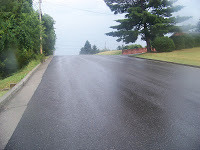 It takes time to grow in love.
It takes time to grow in love.This is not an excuse for being lazy. If I sit back and say, "It takes time..." and use that as an excuse to do nothing, to say "I'll put off loving until tomorrow"--nothing can grow. Tomorrow never comes.
I'll be the first to admit that I'm lazy. We're all lazy. Let's face it.
But let's also dwell on this fact: if we are lazy, we will never grow in love.
These words, "growing in love," sound like a platitude. This is because we don't recognize that we are made for love, that all the turmoil inside of us is the anguished cry of our being, the cry for love. Even underneath our laziness is a kind of desperation to hold onto what we have, because we don't know if there is anything out there "beyond ourselves" and we don't want to take the risk.
But really, are you satisfied with what you have now. Really?
But then comes the other side of our laziness: discouragement. "I have tried to love before, but all I've done is mess things up. I don't know how to love and I don't want to try. It's too dangerous!"
This is a moment where my freedom is challenged in a critical way. I have a choice. I can give in to discouragement. Or I can acknowledge my poverty, and beg for help.
So we cry out for help. And maybe it feels like a waste of time, because help doesn't seem to be coming. But that is not true. Look! We are already doing something. In that begging is already the recognition that we need to love and to be loved. In that begging is already the recognition that there is someone worth loving. If I were really alone, it would never even occur to me to ask. Someone is already here, helping me now.
So I begin to love. And when I fail, I get up and try again. Because it takes time to grow in love.
Published on July 18, 2013 18:30
July 16, 2013
Newlyweds in Italy: Florence, Ravenna, Milan, and the Sea
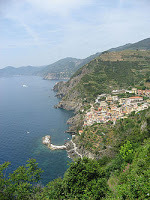 July 10-15, 1996
July 10-15, 1996There is much more in the travel journal about our ongoing adventures, as we traveled to Florence, then to Ravenna, then to Milan and Monza, and finally to Liguria on Italian Riviera. Most of this time we visited friends, and benefited from their hospitality. I wrote about art and faith, the vistas of Florence and its tiled rooftops, Michelangelo (of course), Beato Angelico (of course), the spectacular Byzantine mosaics of Ravenna, and the incredible food that we ate everywhere we went.
Friends who knew these places well would take us to the local restaurants where there was real regional cuisine (like the fresh fish and seafood outside of Ravenna), or even better, sit us down to something right from the kitchen (like a "coniglio cacciatore" at a country farm -- "coniglio" means "rabbit" and in this case we are talking about fresh rabbit).
My journal from these days is priceless in its recording of details that evoke vivid memories. Perhaps I'll post more of these reflections another time. I want to conclude these reminiscences with a vivid memory of a moment spent by the Mediterranean sea on July 15, 1996. Our trip was coming to an end, but of course our journey together continues.
[Walking with our friends], we traveled to the lookout tower on a jutting cliff near Vergognia. After a fairly brief but strenuous hike, we arrived at the clearing at the base of the tower.
Here, some 40 years ago, a young Italian priest used to take his students during their retreats, to show them the beauty of the sea. The clearing at the edge of the cliff looks smaller in life than it does in those early photographs of Fr. Giussani and his little group of "Student Youth." But we were able to relive the breathtaking sense that they must have had looking at the utterly clear blue water and the coast stretching out in either direction.
Three of us decided to climb the tower. But Eileen preferred to stay in the clearing. The tower was used as a lookout in earlier centuries. Berber pirates would attempt to raid the coastal towns; from the towers placed at various points, their approach could be seen on the horizon and the towns alerted by means of fire signals.
From the top of the tower we commanded a slightly more amplified view. We stayed there for a few minutes before rejoining Eileen. From the tower, I looked at her -- alone and thoughtful -- sitting on the low rocky wall at the edge of the clearing, gazing out at the shiny, aquamarine sea with the breeze lifting the dark strands of her hair, and with heart filled with quiet wonder and awe. This is the woman I love....
So ends the journal of June-July 1996, with an ellipsis that indicates a love and a journey that are far from finished. Now, in the year 2013, we carry on with both.
Today we travel in places more amazing than the mountains or the sea or any work of art: we travel with these five miraculous human beings, each of whom is a person called into existence by God's omnipotence and love, created in His image, worth more than the whole universe, destined for eternal glory. The faces of our children continue to be signs to us that our love for each other is a gift. It is not our possession. It has been entrusted to us.
Published on July 16, 2013 11:13
July 14, 2013
True Joy is Born From an Encounter

True joy doesn’t come from having things. It’s born from the encounter,from the relation with others.It’s born from feeling accepted,understood, lovedand from this acceptance,this understanding and this love;and not because it’s of interestfor the moment,but because the other is a person.Joy is bornfrom the gratuitousness of an encounter!
~Pope Francis
Published on July 14, 2013 20:48
July 12, 2013
Newlyweds in Italy: Assisi, part II
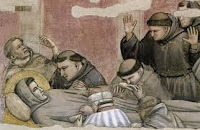 Giotto: Death of St. FrancisFrancis is entirely a living image of Jesus, and his whole life is nothing but a radical testimony to Jesus. Still, it is fascinating to see how people who don't believe in Jesus, or even in God, are drawn to this place. They bring their hopes to this place. Perhaps it is the kindness of Francis, not only to persons but to all creatures -- his experience of communion with all of reality, his capacity to address everyone and everything as "brother" or "sister" -- perhaps this aspect of Francis's character draws people of every kind to go there.
Giotto: Death of St. FrancisFrancis is entirely a living image of Jesus, and his whole life is nothing but a radical testimony to Jesus. Still, it is fascinating to see how people who don't believe in Jesus, or even in God, are drawn to this place. They bring their hopes to this place. Perhaps it is the kindness of Francis, not only to persons but to all creatures -- his experience of communion with all of reality, his capacity to address everyone and everything as "brother" or "sister" -- perhaps this aspect of Francis's character draws people of every kind to go there.Of course, people distort the image of Francis to fit their own preconceptions. Still a spark of the mystery of the human vocation can shine through even the distortions. Francis resists being reduced to an environmental activist, or as someone who brings "peace" through sentimentality. He remains the man who abandons everything that we think is important in life in order the follow that which our hearts tell us is truly necessary. So many wandering and confused people look for a sign that "conflict and emnity" are not the final words on life. We are called to be brothers and sisters, and to be at home in our world as we journey through it. Francis finds everything by giving it all up to follow Another who is greater than everything.
People are drawn to this because grace is at work in their hearts. Only God knows what so many take away from their visits to Assisi, their "anonymous pilgrimages" -- these journeys of restless hearts that do not know (or are afraid to admit) that they are searching for true peace.
We believe in Jesus, and yet we are searching for a deeper and ever more pervasive conviction that He really and truly renews all things in Himself. In Francis, that conviction is radiant, and stones and paint, streets and hills, grass and foliage and even sun and moon still speak about his witness, after 800 years.
From the travel journal, July 1996:
In the upper church of the basilica we marveled at the magnificent frescoes of Giotto portraying the life of St. Francis. We were helped significantly by our guide book, but I was helped most of all by Eileen's deep spiritual attunement to the work of Giotto. It was incredible to think that these were painted within living memory of St. Francis.
All of the painting in the basilica radiates the glory of the events themselves; it emerges from an immersion into the actual experience that had been generated by the grace of the Holy Spirit around St. Francis and his original followers. This is perhaps the secret to the transcendent humanism of Giotto's figures; this is why they are so humanly real and so "iconic" at the same time. Their tender realism draws us from concrete human forms situated in the world to the Infinite God who became man.
In the afternoon we strolled all around the town. Or, rather, at times we strolled and at other times we hiked. Everywhere there were beautiful vistas, hidden alleys that wound through little nooks between the buildings, and a pervasive sense of peace. We had a few moments in St. Clare's church, and we watched the sun set behind the hills, the cupolae, and the bell towers of Assisi from the heights of the Piazza Santa Chiara.
And the moon shed a gentle light on the streets that night.
The next morning, on our way to the basilica of Santa Maria Degli Angeli, I bought a new pair of brown leather walking shoes (Eileen had bought shoes last week in Rome).
This grand 17th century basilica was built to surround and enshrine the Portincina chapel. In the early 1200s, this tiny chapel was all by itself in the woods outside the city. Francis loved to come here to pray; and later he came with his first friends to live. Finally, he came here to die -- another chapel in the modern basilica marks the place (which had been the infirmary of the "little brothers") where Francis died. In the painting, his disciples are kissing the holy wounds on his hands and feet.
It was time for our journey to continue. But it was difficult to say goodbye to Assisi.
Published on July 12, 2013 19:00
July 11, 2013
Newlyweds in Italy: Assisi
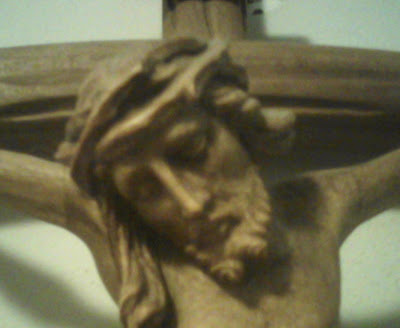 Detail from the hand carved, olive wood crucifix we bought in Assisi, and then
Detail from the hand carved, olive wood crucifix we bought in Assisi, and thencarried for the rest of the trip, on trains, buses, cars, and finally on the plane home.
We have it now on the wall in the small entrance room to the left of the front door
of our house (basically part of the living room -- I can see it now as I write this).
July 7-8, 1996. From my travel journal:
After a week and a half in Rome, we left early on this morning [July 7] for a new destination in our pilgrimage -- Assisi. As the train climbed into the Umbrian hills, we immediately sensed the change in atmosphere. We were leaving the chaos, the noise, and the contradictions (as well as the spiritual and historical vastness) of Rome, and entering into a place of quiet and simplicity of focus.
For Christians, Rome is the second greatest place of pilgrimage in all the world (second only to Jerusalem and the Holy Places). But it is also many other things: tourist center, historical, archaeological, and artistic center, economic and political center, and now also -- in these most recent years -- immigration center.
The proportions of Rome are everywhere huge -- supernatural grandeur, human grandeur, but also "splendid vices," and (today especially) ever enlarging tunnels of physical and personal misery. Assisi is something markedly different. Assisi is a place of pilgrimage... and nothing else.
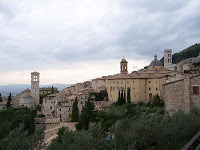 Assisi, a place of pilgrimageThe first thing that struck me in the train station (and that continued to strike me throughout the visit) is that everyone visits Assisi as a pilgrim. This does not mean that everyone knows why they have come here. But the whole of Assisi is centered upon one thing, and everyone comes here on account of that one thing.
Assisi, a place of pilgrimageThe first thing that struck me in the train station (and that continued to strike me throughout the visit) is that everyone visits Assisi as a pilgrim. This does not mean that everyone knows why they have come here. But the whole of Assisi is centered upon one thing, and everyone comes here on account of that one thing.That "one thing" is a man. One man who lived 800 years ago. One human being who fascinates everyone. Francis.
Indeed, every saint generates fascination; it is of the nature of a saint to fascinate (because holiness is true and good and beautiful). But Francis fascinates like no one else. He remains a living icon of Christ and a living icon of the human vocation in its purest and most transparent form -- which is simply to find the truth, and to love... to love "without measure," to love "madly" ; indeed to love without measure because the Beloved is immeasurable, to love madly because the Beloved is good and beautiful beyond every limit of human calculation.
We had all of our baggage with us, so we stayed in a small hotel right across the street from the train station, at the foot of the hill where the old medieval town rises up to the sky. The window of our room had a perfect view of Assisi.
After checking in, we went immediately up the hill (in a bus) to the Basilica of San Francesco, where we attended the high Mass and then visited the crypt. There is the tomb of St. Francis, surrounded by the tombs of his first and most beloved brothers. I was struck by the power and the palpability of the affection of this most extraordinary companionship.
Above all, however, I was amazed by the pilgrims. They prayed at the tomb, kissed the ground in front of it, and pressed their heads against the grating in order to draw closer, as though they could perhaps rest their heads in the bosom of Francis. Nowhere did I see mere curiosity. Hearts were exposed here; the unfathomable human desire was wrestling its way toward the surface of those faces that crowded around St. Francis in the tiny crypt.
I held the hand of my dear Eileen and entrusted all the prayers of our pilgrimage to Francis's singular heart. We prayed that we might, in some way, begin to love Christ (and each other, and our vocational circumstances) the way he did....
[Later that afternoon] we came upon a little shop where Eileen and I were both struck by a beautiful, hand carved olive wood crucifix in the window. We loved the reverent noble simplicity of Jesus's face -- the simplicity of an abandonment to the will of the Father, expressed without any artificial sentimentalism and evidently carved with devotion.
The woman in the shop told us that her father carved the crucifix himself. It was quite large (two and a half feet long) and it cost 250,000 Lire [that's Italian currency in 1996, before the invention of the Euro], which equals about $160.00, but we decided to buy it. We both loved it so much that we thought it would be perfect for our bedroom [in fact, it has always been in the most prominent place in the house, near the front door].
It is a true work of art in its own right; a work of religious art by a person who has probably breathed the air of this holy place all his life.
...to be continued.
Published on July 11, 2013 19:00
July 8, 2013
Newlyweds in Italy: More Days in Rome
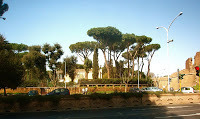 July 4-6, 1996
July 4-6, 1996My travel journal records many adventures we had in our remaining days in Rome. We visited the Vatican museums and the Sistine Chapel, took lots of walks, had picnics with fresh cheeses and wine and oranges that fell from the trees.
We saw the ruins, and went, of course, to the Colosseum (when I lived in Rome, I used to walk by the Colosseum several times a day, to the point where I began to think of it as "the place that's full of cats at night"). We went to catacombs, churches, and basilicas, where we prayed and gazed at the art and architecture of the centuries: byzantine mosaics, medieval statuary, Caravaggio. We ate in restaurants and spent time with some of our Italian friends.
My journal especially notes that we visited the great Jesuit churches in the center of Rome. Here one can find real masterpieces of the Baroque period, that are so brilliant and so much better than the cheap 19th century imitations that one finds in many Italian churches (and used to find in American churches). This is what I said about Jesuit high baroque in the journal, in 1996:
Here the Baroque style achieves its real grandeur: a great, symphonic jubilation in which heaven and earth are embraced and joined together by means of the spiritual ardor of the Christian personality. The "inscape" of Ignatius's charism and the impetus of the Jesuit mission are here expressed in a baroque sensuousness that is at the same time truly iconic. We are given an "artifact," a work fashioned by human perception and skill, that has a truly "sacramental" quality; it is a means for the contemplative encounter between man and the mystery of God.... Here baroque excess works. It serves as an icon for the excess of love.
 Batoli's "Sacred Heart" in the Chiesa Gesu:
Batoli's "Sacred Heart" in the Chiesa Gesu:the real thing, that has been copied (most of
the time badly) for over 300 years. We have
a photo of the real Batoli in our living room.I wrote a lot of stuff like this in the journal. Yes, it was our honeymoon, and I was tinkering with thoughts about the difference between an "icon" and a picture that is simply a work of art with a religious theme. I was convinced that there was still iconography (in a theological sense) in post-medieval Western art forms. I'm always thinking about something!
I was really lucky that Eileen fell in love with me.
That and more! She inspired me and encouraged me to ponder things, and over the years she has filled in many gaps in my own understanding with her literary expertise, her exquisite poetic sense, and her perspective as a woman and (now) a mother.
By the time of our wedding, Eileen and I had already been friends for six years, and for much of that time it was a friendship over a distance of a thousand-or-more miles, in the days when the "social media" were the telephone and the Post Office. We used both extensively to communicate with each other, keeping up the friendship we had formed in 1990, when Eileen lived in Washington, DC and we had first met and spent time together. We became quite close, and remained so over time and distance. But for a long time -- because of a variety of circumstances and commitments -- our relationship didn't have the chance to take the further step that, in retrospect, seems so obvious and natural.
Still, we always had (and still have) a true "intellectual friendship." Really, I'm serious. This has nothing to do with "platonic love," but rather with the fact that we always wanted to be together looking at all kinds of things, asking questions, and trying to understand them. We were two people who were interested in... well... pretty much everything. But our interest was (is) expressed in complementary ways. Thank God!
When we were finally in the same place again, and the circumstances of our lives were clear, it became a simple thing to see that we loved each other. That wasn't until 1995. But it finally did happen.
I am so out-of-this-world grateful that God brought us together.
We spent a week and a half in Rome, and then we were ready to head to Assisi, to continue our pilgrimage, our explorations, our honeymoon. And it really was a honeymoon! All of the depth and fascination of these places did not distract us from each other; on the contrary it enriched our experience of being together. We were newlyweds, and we were living for the first time the adventure of being married. Our lives were growing together in new ways.
Published on July 08, 2013 19:00
July 6, 2013
Its a Miracle Indeed!
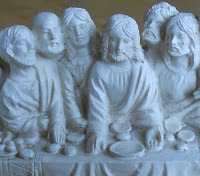 We have recently heard the beautiful (but not unexpected) news that Pope Francis has given his final approval for the canonization of Blessed John Paul II. A very rigorous scientific, theological, and ecclesiastical investigation has given its recognition to what the Church calls a miracle.
We have recently heard the beautiful (but not unexpected) news that Pope Francis has given his final approval for the canonization of Blessed John Paul II. A very rigorous scientific, theological, and ecclesiastical investigation has given its recognition to what the Church calls a miracle.A woman in Costa Rica was completely healed of a cerebral hemorrhage shortly after watching John Paul II's beatification on television. She has testified that she heard him speak to her from a magazine picture.
At this point, people might start rolling their eyes. But this is not the end of the story. Her doctor was amazed to find that her brain hemorrhage (which was of a particular kind, and which neurologists have subjected to very careful study) was simply gone... without a trace. It wasn't a "reversal," or a remission or some kind of gradual (albeit unusual) healing process. It had simply disappeared.
People get "the willies" when they hear this kind of stuff. People say, "ho, there must be some natural explanation...."
This is not an unreasonable reaction. In fact, no one gets "the willies" about these things more than the Catholic Church. The Church receives so many reports of "miracles" that all the hard drives and clouds of the cyberworld do not have enough bytes to hold the data that would be needed to contain them! The vast majority of these phenomena are handled by the pastoral care of local churches. Very few reports make it to the Vatican. And the vast majority of those reports, even, don't pass the Vatican's tremendously strict scientific standards.
But in this case, the doctor, his professional colleagues, and other experts were amazed. The woman was tested further. The amazement only grew.
But even the amazement of scientists is not enough for the Church.
When considering a reported miracle in a canonization cause, the Church asks scientists if there is any possible natural explanation for what has taken place. Scientists have to go beyond what they immediately see, in order to consider what might be possible.
Finally, the report goes to the medical board of the Congregation for the Causes of the Saints. A panel of experts is assembled. Non-believing scientists are welcome, indeed encouraged to participate. This panel passes on their assessment, and only if they have concluded that the event cannot be explained by natural causes does the report proceed to the next stages of evaluation.
For all practical purposes, its impossible to cheat this process. Contrary to widespread prejudice, the Church is not credulous or superstitious. The formal recognition of a miracle comes only after an extremely cautious and rationally exhaustive investigation by scientists, i.e. people who work in their fields and who do not work for the Church.
Only at this point does the Church's authority take up the consideration of the event as a special divine action, and whether or not it can be directly linked to the prayers of a figure being considered for sainthood.
The term miracle is often misunderstood. A miracle is an event that takes place through the extraordinary intervention of God in the world. A miracle is a work of God. When a person prays to a saint for a miracle, the result is not that the saint performs it by his or her own power. Rather the saint, who remains united with people on earth as a brother or sister in God's great family of love in Christ, prays to God with the person and for the person. If God wills it, He performs the miracle in response to the prayers of the saint.
Sometimes we say, "Saint Joseph cured me," but this is a kind of shorthand. What we mean by this is that "God cured me in answer to the prayers of St. Joseph" or "through the intercession of St. Joseph."
Of course, everything is a miracle, in a way. Everything comes from the Mystery of God who creates and sustains all things in their being and activity. But the God who utterly transcends all things can act with a special expression of His power and love that goes "beyond" the order of the universe that He creates and sustains. These are the "miracles" -- the "works of wonder" -- in which He reveals and communicates in a more profound way His goodness within the world.
The fundamental "miracle" at the center of the whole universe and in the life of every person is the stunning fact that God took on our human nature and became one of us, and that He dwells with us in Jesus Christ who lives in the Church.
The focus of the life of the Church is the miracle of the Eucharist in which Jesus is substantially present -- body, blood, soul, and divinity -- under the appearances of bread and wine. The Eucharist is not a merely symbolic commemoration of something that happened two thousand years ago. It is Christ present, here and now, so that crucified love can enter into and transform you and me. This is a miracle indeed.
It is also a miracle that the human being is raised up in Christ to a participation in the life of God, who is the communion of Eternal Love. And the human being sees more and more that the miracles of God's love are everywhere, penetrating every circumstance with His presence.
It is not surprising that we believe in miracles. We are called to a miraculous life of communion with God.
It is helpful to us and to the world, however, that God's power and love sometimes flow over into further wonders. Sometimes God manifests His saving presence in a special and unusual way that results in concrete effects that can be analyzed (up to a point) by human understanding within the more mundane realms of the empirical sciences, or even in a way that is evident to the simple observation of the human senses.
These are the kind of events we tend to call "miracles" -- the blind see, the lame walk, the withered hand is restored before one's very eyes, ravaging diseases disappear. These things happen in ways that can't be accounted for by ordinary causes; they go beyond anything that can be explained by the internal workings of the universe. They are special acts that have God's signature upon them -- special interventions of God's power, authority, goodness, and compassion.
It is important to emphasize again that only God can perform miracles. Jesus did such things on His own authority as a way of manifesting that He was God. A created person, however, can at most be an instrument or an occasion for a miracle, which remains the expression of God's sovereign power. It is the furthest thing from any kind of trick or abnormal event brought about by a person's harnessing of some hidden intraworldly power. It is not magic or fakery or superstition. It is the hand of God at work in our midst
The Church looks for a true manifestation of God's presence, power, authority and love in action -- a publicly verifiable "miracle" -- when she canonizes a saint. This is because the veneration of the saints involves the public invocation of their prayers by the Church in her liturgical worship, and the saints being proposed as special friends and helpers in the lives of the faithful. The life of the saint who is now in glory can be set forth for the inspiration and imitation of others. And the faithful are encouraged to pray to them with confidence. Through miracles, God gives clear signs that He wills to continue to spread His love in the world in particular ways through the prayers of the saints who live eternally in Jesus Christ.
Published on July 06, 2013 19:00
July 3, 2013
Newlyweds in Italy: Meeting Blessed John Paul II
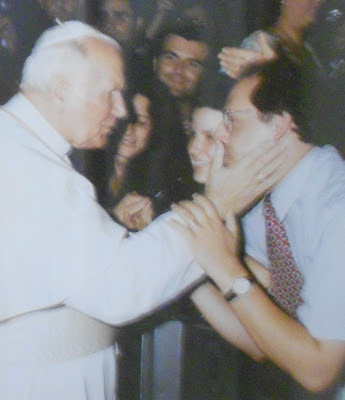
"This was a day of a truly incredible blessing."Travel Journal, Wednesday, July 3, 1996
On the previous day, my new wife and I had obtained "Sposi Novelli" tickets to Pope John Paul II's Wednesday audience. The first several rows in front of the hall were reserved for various groups, including newlyweds. We thought we might have a close look at the Pope, from those front rows.
But as we boarded the bus back from the Vatican on Tuesday afternoon, we saw an old friend of mine, Fr. Sylvester Catallo, a Capuchin priest who could have been Padre Pio's twin, and who had been pastor of St. John the Evangelist in Woodstock, Virginia years ago, when I was in college. I had taught CCD there in 1982. He and his pilgrimage group were getting off the bus, so we spoke briefly. We told him about the tickets, and he said something very important: "Go and get on the line first thing in the morning. Get there as early as you can. If you get seats in the front row you can meet the Pope!"
We arrived on Wednesday morning before 9:00 AM, and the Swiss Guards took us through a special entrance. Thus we found seats in the front row of the Paul VI Audience Hall, right behind the famous waist-high barricade that one always used to see in pictures of the Pope greeting people at the General Audiences. In time we would see how right Fr. Sylvester had been. The area was soon packed with people as was the rest of the hall. Only those in front, scrunched against the barricade, had any chance of touching the Pope much less speaking with him personally. But we would make the most of our chance.
The Pope arrived at noon and spoke to the crowded hall. He received delegations and greeted pilgrims from different nationalities, who responded in the crowd with cheers and the waving of flags and banners. And here we take up the travel journal:
Finally, the Pope began to make his way along the front of the crowd. We were crunched on every side. When he came close, there was something that I sensed for the first time (after having seen the Pope so many times from a distance) -- the simple human warmth, the affectionate nature, and also the human vulnerability, the enormous vulnerability of this man who is not a "religious superstar," but who is a man, created with a need to love and to be loved.
When he stood before me and Eileen, we touched him and embraced him (burying face, lips, anything available, against his hands and arms) as though he were our Grandpa. Without any loss of reverence, we were filled with an overflowing and spontaneous affection, a familial affection.
We had a brief conversation. We told the Pope that were were from America, that we were newlyweds on pilgrimage to Rome, and that we desired his blessing on our marriage. And so the Pope placed his hand on each of our heads and traced the sign of the Cross while pronouncing his benediction.We spoke for a moment. We gave him one of our wedding cards with the verses from John 17 ("that they may be one..."). Above all, we told him that we loved him. He looked tenderly into Eileen's eyes, and then he patted me on the cheek (as shown in the Vatican Press Office photograph, one of several we were able to purchase later on).
Finally, he began to move on, greeting others who stuck their hands out next to us, speaking again in Italian. [But I couldn't suppress my overflowing, excessive nature, and for once I'm glad I didn't.] I shouted to him one last time, "We love you, Holy Father!" And as he continued down the row, he spoke again very distinctly in English, "God bless you."
And so our marriage was blessed, personally, by the Pope. Also, I believe, we gave something to him; we were able to express personally to him the affection we have for him on account of the love and the suffering that shape his whole mission, and through which he has given us so much. And I think that we gave him comfort -- we stayed with him, even if only for a moment, and our companionship with him in Christ was evident, and was a source of strength for us and also for him.We believe we received a great grace on this day, seventeen years ago. And now with our five children and many years of joys and trials, we have seen this grace continue to unfold in our marriage and family life. For his part, Blessed John Paul II (now on the threshold of being declared a canonized saint) offered his sufferings for the Church and for every human being during the rest of his life, and in the remaining eight-and-a-half years of his long Way of the Cross he carried us along with so many others. Then, almost from the moment of his death, I sensed with confidence his intercessory closeness, his new way of continuing a companionship with us.
This picture is now a uniquely personal icon in our dining room. The greatest saint of our times -- and this great apostle of the sanctity of marriage and the family -- seems to be holding me and Eileen in his strong arms, and I know that his prayers accompany us in suffering and many trials. Every day I pray for his intercession: "Hold on to us, keep us always together, and obtain for us God's blessing."
His intercession is powerful before God, and I know that he will pray in the same way for any couple who invokes his aid, or any person.
Published on July 03, 2013 15:58
July 2, 2013
A Simple Contemplative Prayer

Pope Francis speaks about the Rosary:
I would like to underscore the beauty of a simple contemplative prayer, accessible to all, great and small, educated and not very educated; it is the prayer of the Holy Rosary.
In the Rosary we address the Virgin Mary, so that she will lead us to an ever closer union with her Son Jesus to be conformed to Him, to have his sentiments, to act like Him.
In the Rosary, in fact, by repeating the “Hail Mary,” we meditate on the Mysteries, the events of the life of Christ to know and love Him ever more.
The Rosary is an effective instrument to open ourselves to God, because it helps us to overcome our egoism and to have peace in our hearts, in our families, in society and in the world.
Pope Francis (speaking to Lithuanian youth, 7/1/2013)
Published on July 02, 2013 19:00



